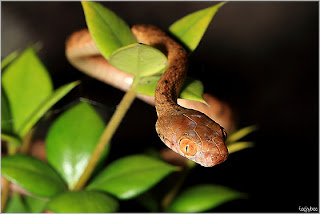It’s spring. The daphne is blooming, the people dressed up as the Statue Of Liberty are hawking tax preparation offices in the strip malls, and the scent of Windex hangs in the air. The annual ants came in last week and set up a bivouac in the kitchen from which to run operations for the next few months, and we have been casting a blessing of Windex over their tiny asses, in what amounts to a minor harassment of the entire organism, which is 40,000 ants strong. We will continue to do so until the day, perhaps in early July, that they decide on their own to move outside. It’s what we do.
When we consider our complete inability to budge our annual ant population in an area as small as our kitchen–not to mention my inability to rout a replicating cold virus in an area as small as my nose–it is ever more wonderful to contemplate the problem that has challenged scientists in Guam, where an army of brown snakes has invaded and multiplied, and cattywamped the local ecosystem. The scientists are trying to come up with a plan to eradicate the invaders and restore the balance of native wildlife. It’s a daunting task. The jungle is much bigger than our kitchen and much, much bigger than my nose, and it’s going to take some creativity to come up with an idea. But that’s what good science does. You must have facts and you must have education, but without creativity science does not advance.
Thus Friedrich Kukele dreams of a snake biting its own tail and wakes up knowing the structure of the benzene ring. Thus an apple drops on Isaac Newton’s head so hard it smacks a theory right out of it. These people succeeded because of the natural ingenuity of the unfettered mind, as much as any artist or musician.
Or, in this case, the very same sort of collaborative creativity exhibited by frat boys with desires, curiosity, a week off, and buckets of alcohol, without which they will never achieve a lifetime of regrettable body art or a possibly fatal road trip.
Yes, the scientists are going to airdrop dead baby mice spiked with Tylenol and wearing parachutes over the jungle in Guam.
This had to be a group effort.
“Ideas, guys, we need ideas.” Jason taps a whiteboard with his marker.
“Let’s bop them on the head!” Ethan is excited. He bounces up and down in his seat.
“You first,” Zach says.
Ethan reconsiders. “Let’s drop things on their heads from a great height!”
BEAN THE SNAKES, Jason writes on the whiteboard.
Katie, off in the corner, rolls her eyes. “Snakes have notably small heads,” she says, feeling tired already. “I think your beaning success rate will be vanishingly small. Perhaps we can come up with something that, I don’t know, works with nature and doesn’t rely so much on adolescent fantasy.”
BEAN THE SNAKES is rubbed off the whiteboard.
“I know! Let’s harness the abilities of a natural enemy of the snakes.”
“Mice!” Ethan puts in. “Mice hate snakes!”
“And yet–” Katie rolls her eyes–“oddly enough, they are not known for being particularly aggressive toward snakes.”
“We use the brooding females. Their protective maternal instinct will kick in over their fear, especially if we arm them. We can give them tiny little hammers! I can totally manufacture a tiny little hammer using 3-D printed material technology.”
“Awesome,” Jason says. Ethan runs out of the room.
Katie rolls her eyes again. “You’re not going to get a mouse to march up to a snake and smack it with a hammer. Especially not a brooding female. They have a forked uterus with fetuses lined up on either side all the way up to the armpits. Once she’s pumped them out, she is not going to care if she comes up a couple short.”
“How do you know?”
“I just do.”
Ethan runs back in brandishing a tiny prototype hammer and the men Superglue it to a mouse’s head. The mouse takes two steps, tips over frontward and pedals its rear feet in the air. “Shit,” Ethan says. “I already made 10,000 hammers.”
The room is quiet for a few moments.
“I know! Katie, you said there is an excess of baby mice?”
“Depends on your perspective.”
“But there is no shortage. We can glue the tiny little hammers to the baby mice and drop them on the snakes! It’s perfect! If we drop them from high enough. We can do a blitzkrieg!”
The room fills with swooping arms, rat-a-tats and World War II bombing-raid plane noises. BEAN THE SNAKES goes back up on the whiteboard. Katie’s eyes are, at this point, permanently rolled up.
“Problem,” Katie says.
“What now?”
“Several things. One, PETA is going to have a conniption. Dropping baby mice out of an airplane! Two, our snakes are not on the ground waiting for death from the sky. They live in the trees. They’re going to be mighty hard to bean.”
“We could pump a painkiller in the mice. They won’t feel a thing. Matthew, go dope up a mouse with Tylenol and see if you can drop it on a snake head. And as for the trees–“
“We could drop them in by parachute! Tiny little parachutes.” Ethan looked ready to bolt from the room again.
“Too slow,” Zach puts in, hurriedly scratching figures on a pad. “Can’t obtain beaning speed.”
“Tiny little parachutes, and tiny little hammers!”
“This is getting complicated.”
“No wait. This could totally work. The baby mice get hung up in the trees by their parachutes. The snakes eat the mice and choke on the chutes.”
Matthew races back into the room. “Dudes! Snake ate the mouse and dropped dead! It’s got to be the Tylenol!”
“Katie and Gentlemen, I believe we have a plan,” Jason says, as Katie wades through a sea of fist-bumps, cheers, and high-fives in search of the Tylenol. “And you know what that means!”
Road trip!



I rolled my eyes when I first read about the mouse thing, but somehow, you make it all seem plausible. And, I'm about to go on a road trip. Great story Murr. You're the best.
ROAD TRIP!! You be keerful out there.
Bugger! Now I've got "Maxwell's Silver Hammer" beating in my head.
I've had that going through my head since the Pope resigned. Not that he died. But they could check.
If that is you in the last photo, I wish I had know you back then. You must have made the lab a circus of laughter!
Not really. I didn't get funny until sometime in the '90s. It was a Tuesday.
The trouble with this post is that I can see it all happening!
This is why fiction is so much fun to write.
"Weird Science" meets "Spring Break". Scored by The Beatles and Oingo Boingo. Call Hollywood now – they need you!
I can totally see my latest novel as a movie…
They should try Windex. Or mongooses (mongeese?). Or mongooses armed with Windex.
Or maybe spike the mice with something stronger than Tylenol, if they're going to go that route. Maybe LSD. With any luck the snakes will tie themselves in knots.
Now there's a vision. And Windex! You're a genius!
I guess Guam is kind of like New Zealand in that it was a bird paradise until the snakes got there, and now they're all gone. (NZ it's just all the ground birds that succumbed.)
🙂 Ya goofy broad ya.
And the people whose job descriptions include the words "and other tasks as needed" suddenly find themselves killing baby mice and stuffing them with Tylenol…
Pearl
…the people whose job descriptions include the words "and other tasks as needed"…
I had those jobs! I think the one I have a picture of up there was one of those.
Disturbingly believable.
And hilarious 🙂
And there's always a Katie to spoil the fun.
Oh wow! I love it. It just rings so true! Inspired!
Unfortunately, I always visualize similar things about the boys cookin' up a war in Iraq and that sort of thing.
Then you might (not?) want to watch "Hubris" tomorrow, Friday, 3.22.13 at 9:00 on MSNBC. I'm thinking that if everybody watches it, and understands why and where our money went, that the current budget talks will be a little easier, and go a little better for those of us aging, and rapidly speeding toward a very insecure future, and better for those who are more vulnerable than we are. (The logic is flawed and I am naive and overly hopeful, but maybe?)
You are naive and overly hopeful. It's the right way to be.
That's hysterical. I love it – hammers, parachutes, mice, Tyelenol, and snakes. Who would've thought? 😀
This is the trouble with writing humor. You try to make this shit up, and it's already happened.
Why am I reminded of the turkey drop episode in WKRP in Cincinnati?
Mass bombing have been the US tactic in meeting every perceived threat since the Civil War. Do you think the reptiles in Congress would suffer the same fate if we dropped a few drugged mice in the lobby?
AS GOD IS MY WITNESS, I THOUGHT TURKEYS COULD FLY.
You DO remember! Awesome!
Wait…back to the Windex and the ants. I thought I was the only person who did that.
Our kitchen always smells super clean in the springtime. Take your bifocals off, and it looks clean, too.
In Puerto Rico they brought in mongooses to take care of the snake problem, not the mongooses have multiplied and they are the problem.
The ants will be the dominant species on earth when we eradicate ourselves.
We just had 14 inches of snow here in western Maine.
the Ol'Buzzard
There is an enORmous list of plants and animals we've brought in to take care of some other problem we has wrought. And we don't have a very good record.
Go Maine go!
Now I am trying to picture the tree of them stuffing Tylenol capsules into baby mice. From the bottom up? Or down the gullet? Maybe strapped to their backs by the parachute? Really. I will be thinking of all possibilities until you tell. Details.
I have actually handled and done horrible things to an untold number of mice in my day. I do not plan to tell the details. It doesn't make me look good.
Vinegar
Wipe down your counter tops, cupboards and any other places where you've spotted ants with a 50-50 mixture of white vinegar and water. Repeat throughout the day to maintain the efficacy.
Why This Works: Two reasons, really: ants hate the smell of vinegar, and it removes the scent trails that they use to get around.
Spinkle cinnamon, mint, chili pepper, black pepper, cayenne pepper, cloves or garlic – whichever one you happen to have – in the area where you've seen ants and along your home's foundation. Bay leaves can also be placed in cabinets, drawers and containers to further deter those pesky critters.
Why This Works: Many plants – including the ones listed – give off a strong scent to repel ants and other insects in the wild, and it works just as well in your home.
The type of food they look for is either sugar or protein, it depends on what the needs of the colony are at the time. This is why a “tried and true” recipe that came highly recommended doesn’t work for you, the bait holds no interest for the particular critters in your home.
Tip: First determine if the ants in your house are after sugar or protein. Leave a sample of each bait out and see which ones they go for. Once you’ve determined what they’re hungry for, set out a few baits with their choice.
Here are a few homemade bait recipes you can try…
Sugar
2 TBS Boric Acid (Borax)
Jam (or Jelly, Honey, Maple Syrup)
Mix the boric acid with the jam or jelly to make a paste. Slather it on a piece of paper, a plate or in a covered container with holes. You may have to adjust amount of Boric Acid if they seem to eat up the bait like crazy, but are getting fatter from it instead of dying.
Sugar
2 cups Sugar
1 cup Water
2 TBS Boric Acid (Borax)
Mix and place in small saucers around the house.
Boric Acid can be harmful if swallowed. If you have kids or pets in the home, set the bait in covered plastic containers with a few holes poked in the sides. You could also use glass jars sealed with lids–just poke holes in the top lid. For strong attraction, smear a bit of non-poisoned bait on top of the lid so they’ll find it easily.
For best results lay out a fresh batch daily.
Lay the bait in areas where you see regular activity and near their points of entry if you know them.
Don’t be diligent washing away their trails, you want them to find the bait spots easily again and again. All the workers in the colony can follow each others trails, so even if you killed off the first foragers, their partners will follow the trail they left.
You may find that a sugar bait will be popular for a few days, then a protein one is needed as they switch to protein foods. Change your method as needed.
If you’ve set out both types (sugar and protein) yet they are attracted to neither, reduce the amount of boric acid used until they starting feasting on the bait.
This website has more information
http://tipnut.com/ant-killer/
More information than THAT? Whoa! Thanks, Rose. I've seen some of this info before but haven't really tried any of it. Except it's probably the vinegar in Windex that works. And how can you tell an ant is getting fat? Does this Boric Acid make my butt look big?
I've written an Ant Post every year for three years or so. Also seem to have an annual Pie Post. I don't try to do this, but there always seems to be something else to say. I'm hoping I won't delve into it any more this year.
I had seen this story and thunk 'boy solution' to myself a little while ago. It needed you to write it though. And Katie rocks.
Well you KNOW they had to be bouncing ideas off each other. Incidentally, one of the rules of writing (so I hear from the Writing Experts) is you should never have anyone rolling their eyes. Boo-yah.
But Katie would totally roll her eyes!
Maybe they inject a Tylenol solution into the dead baby mice to speed the delivery process.
The snakes first came to Guam in the wheel wells of American fighter planes during WWII. Don't ya just LOVE the tropics?
I'm always surprised at what stays stashed in wheel wells. I can't even get my drink to not spill but dem critters is hanging on.
Well…..I'm speechless! I have no idea where to start in terms of responding to that!
Zany and bizare!!!! I am smiling though!xxxxx
I guess they're really hoping it works, in Hawaii. Where they are very afraid of accidentally imported snakes. Which could do in the introduced chickens.
I got distracted by that pretty snake. But you know… the plan could just work. I fed my python dead rats and he never seemed to suspect a thing.
Well. Right off, you're starting with rats. The culinary standards are already low.
OMFG… Had I not clicked the link, I would have believed this was just another delusion, uh… I mean creation of your well-regarded imagination. I guess we should just be happy that considering the idea is coming from a U.S. airbase, they're not just going to Agent Orange the whole place.
You know, I hardly EVER make this stuff up, even if I don't provide a link. My problem is when I try to use hyperbole or make up something really out there when it comes to conservative politics, and I don't succeed because someone has already done/said it for real.